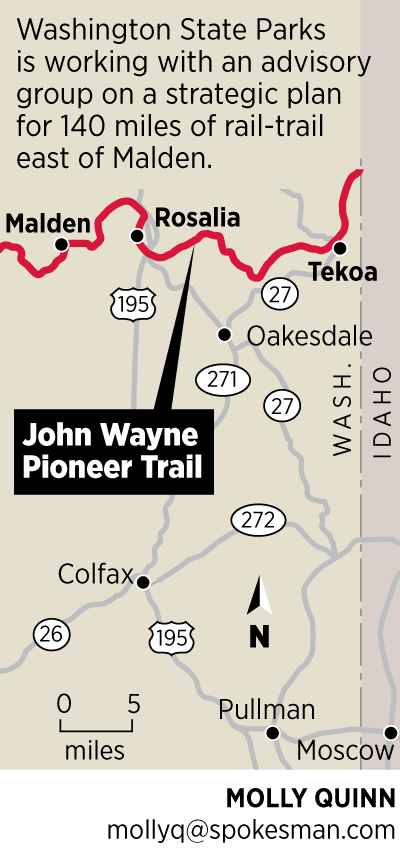John Wayne Trail planning meeting Tuesday in Cheney

John Wayne Pioneer Trail public meetings are planned this week as state officials seek comments on developing the controversial cross-state railroad corridor.
Washington State Parks and Recreation Commission staff will make a presentation on the status of the route, which extends 285 miles from North Bend to the Idaho border and comprises most of the former Milwaukee Road right of way.
The meetings are set for 6 p.m.:
- Tuesday at the City Hall Auditorium, 609 2nd St., in Cheney.
- Wednesday at the Student Union and Recreation Center, Central Washington University, 400 E. University Way in Ellensburg.
Planning for the 110-mile western portion of the abandoned railway from Cedar Falls (near North Bend) to Beverly Bridge on the west side of the Columbia River was completed in 2000. This portion of the trail is better known as Iron Horse State Park.
The portion of Iron Horse State Park from from the Columbia River eastward to the Washington-Idaho border near Tekoa is called the John Wayne Pioneer Trail.
In 2014, State Parks completed a plan for the 34-mile section of railroad corridor between Malden and Idaho.
The current planning process will address the 140-mile portion of the route from Beverly Bridge to Malden.
Adjacent landowners have complained about the trail since the Washington Legislature approved purchase of the corridor in 1981.
Aside from an annual multiday tour by a horse-and-wagon group based out of Ellensburg, the trail is lightly used, partly because of a confusing state permit system.
However, the growing popularity of fat-tired bicycles is bringing new interest to riding the trail, which has many rough stretches.
According to parks officials, top trail-related issues include noxious weed and vegetation management, trailhead and camping opportunities, fencing and requirements for trail-use permits.
In December, State Parks began working with a 12-member advisory committee to produce a plan to address management and recreational use issues.
The advisory committee members represent a range of trail interests, including adjacent landowners, the Tekoa Trestle and Trails Association, agriculture, tourism and economic development, natural resources, historic and cultural resources, hikers and walkers, cyclists, equestrians and utility providers
Allen Widman, one of four adjacent landowners in the group, said the two meetings of advisers so far have not convinced him that state parks “has the will or the funding “ to address landowner issues.
“Parks already has a huge backload of maintenance on existing parks,” he said.
“The reason they give for not spraying weeks, building fence or sending out a ranger when there’s a problem is that there’s no money for that,” he said.
“The bridges and trestles haven’t been inspected for safety. Decks are disintegrating. It’s going to cost untold millions of dollars to bring the corridor up to useable condition.”
State Parks last year began requiring adjacent ranchers and farmers to pay for a permit to move cattle or machinery along the trail. The move has been criticized by trail users as well as landowners.
“That’s nuts,” said Chip Andrus, a Spokane rail-trail supporter who spoke at a November public meeting in Rosalia. “Landowners should be treated as trail partners.”
“I’m not totally opposed to the trail,” Widman said, “but the money they’d have to spend to make it useable is out of reach.”
Ted Blaszak of the Tekoa Trail and Trestle Association said the group and the state are pursuing a $1.2 million grant to repair the Tekoa Trestle.
The Washington Senate has approved $100,000 for controlling noxious weeds along the trail in the state’s supplemental budget. The measure has yet to be considered by the House.
Parks officials say they’re applying for a federal grant of nearly $1 million.
Written comments on the trail can be posted on the Washington State Parks webpage devoted to John Wayne Pioneer Trail planning at parks.state.wa.us/979.